Gynecomastia is a medical term that comes from the Greek words for "women-like breasts." Though this oddly named condition is rarely talked about, it's actually quite common. Gynecomastia affects an estimated 40 to 60 percent of men. It may affect only one breast or both. Though certain drugs and medical problems have been linked with male breast overdevelopment, there is no known cause in the vast majority of cases.
For men who feel self-conscious about their appearance, breast-reduction surgery can help. The procedure removes fat and or glandular tissue from the breasts, and in extreme cases removes excess skin, resulting in a chest that is flatter, firmer, and better contoured.
If you're considering surgery to correct gynecomastia, this brochure will give you a basic understanding of the procedure--when it can help, how it's performed, and what results you can expect. It can't answer all of your questions, since a lot depends on your individual circumstances. Please be sure to ask your doctor if there is anything about the procedure you don't understand.
Surgery to correct enlarged male breasts can be performed on healthy, emotionally stable men of any age. The best candidates for surgery have firm, elastic skin that will reshape to the body's new contours.
Surgery may be discouraged for obese men, or for overweight men who have not first attempted to correct the problem with exercise or weight loss. Also, individuals who drink alcohol beverages in excess or smoke marijuana are usually not considered good candidates for surgery. These drugs, along with anabolic steroids, may cause enlarged male breasts. Therefore, patients are first directed to stop the use of these drugs to see if the breast fullness will diminish before surgery is considered an option.
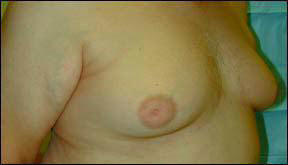
All surgery carries some uncertainty and risk
When male breast-reduction surgery is performed by a qualified plastic surgeon, complications are infrequent and usually minor. Nevertheless, as with any surgery, there are risks. These include infection, skin injury, excessive bleeding, adverse reaction to anesthesia, and excessive fluid loss or accumulation. The procedure may also result in noticeable scars, permanent pigment changes in the breast area, or slightly mismatched breasts or nipples. If asymmetry is significant, a second procedure may be performed to remove additional tissue.
The temporary effects of male breast reduction include loss of breast sensation or numbness, which may last up to a year.
Many men have gynecomastia (enlarged, female-like breasts) caused by excess glandular tissue or fat (or both).
Planning your surgery
The initial consultation with your surgeon is very important. Your surgeon will need a complete medical history, so check your own records ahead of time and be ready to provide this information. First, your surgeon will examine your breasts and check for causes of the gynecomastia, such as impaired liver function, use of estrogen-containing medications, or anabolic steroids. If a medical problem is the suspected cause, you'll be referred to an appropriate specialist.
Your plastic surgeon may, in extreme cases, also recommend a mammogram, or breast x-ray. This will not only rule out the very small possibility of breast cancer, but will reveal the breast's composition. Once your surgeon knows how much fat and glandular tissue is contained within the breasts, he or she can choose a surgical approach to best suit your needs. Don't hesitate to ask your surgeon any questions you may have during the initial consultation- including your concerns about the recommended treatment or the costs involved. Treatment of gynecomastia may be covered by medical insurance--but policies vary greatly. Check your policy or call your carrier to be sure. If you are covered, make certain you get written pre-authorization for the treatment recommended by your surgeon.
Glandular tissue must be cut out, usually through a small incision near the edge of the areola. Sometimes, a small drain is inserted through a separate incision to draw off excess fluids. Once closed, the incisions are usually covered with a dressing. The chest may be wrapped to keep the skin firmly in place.
Your surgeon will give you specific instructions on how to prepare for gynecomastia treatment, including guidelines on eating, drinking, and taking certain vitamins and medications.
Smokers should plan to stop smoking for a minimum of one or two weeks before surgery and during recovery. Smoking decreases circulation and interferes with proper healing. Therefore, it is essential to follow all your surgeon's instructions.
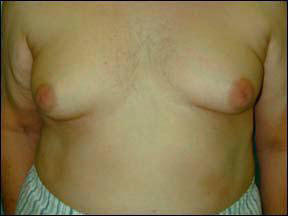
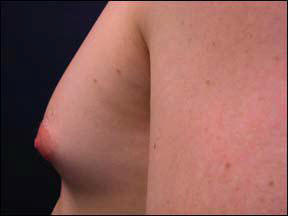
Where your surgery will be performed Gynecomastiatreatment is most often performed as an outpatient procedure, but in extreme cases, or those where other medical conditions present cause for concern, an overnight hospital stay may be recommended. The gynecomastia treatment itself usually takes about an hour and a half to complete. However, more extensive procedures may take longer. incision to draw off excess fluids. Once closed, the incisions are usually covered with a dressing. The chest may be wrapped to keep the skin firmly in place.
Type of anesthesia
Gynecomastia treatment may be performed under general, or in some cases, under local anesthesia plus sedation. You'll be awake, but very relaxed and insensitive to pain. More extensive correction may be performed under general anesthesia, which allows the patient to sleep through the entire operation. Your surgeon will discuss which option is recommended for you, and why this is the option of choice.
The surgeryIf excess glandular tissue is the primary cause of the breast enlargement, it will be excised, or cut out, with a scalpel. The excision may be performed alone or in conjunction with liposuction. In a typical procedure, an incision is made in an inconspicuous location--either on the edge of the areola or in the under arm area. Working through the incision, the surgeon cuts away the excess glandular tissue, fat and skin from around the areola and from the sides and bottom of the breast. Major reductions that involve the removal of a significant amount of tissue and skin may require larger incisions that result in more conspicuous scars. If liposuction is used to remove excess fat, the cannula is usually inserted through the existing incisions.

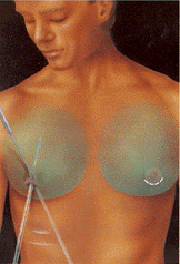
If your gynecomastia consists primarily of excessive fatty tissue, your surgeon will likely use liposuction to remove the excess fat. A small incision, less than a half-inch in length, is made around the edge of the areola--the dark skin that surrounds the nipple. Or, the incision may be placed in the underarm area. A slim hollow tube called a cannula which is attached to a vacuum pump, is then inserted into the incision. Using strong, deliberate strokes, the surgeon moves the cannula through the layers beneath the skin, breaking up the fat and suctioning it out. Patients may feel a vibration or some friction during the procedure, but generally no pain. In extreme cases where large amounts of fat or glandular tissue have been removed, skin may not adjust well to the new smaller breast contour. In these cases, excess skin may have to be removed to allow the removing skin to firmly re-adjust to the new breast contour.
Following surgery for gynecomastia,the patient has a more masculine chest contour.
Whether you have had gynecomastia excision with a scalpel or liposuction, you will feel some discomfort for a few days after surgery. However, discomfort can be controlled with medications prescribed by your surgeon. In any case, you should arrange to have someone drive you home after surgery and to help you out for a day or two if needed.
You'll be swollen and bruised for awhile--in fact, you may wonder if there's been any improvement at all. To help reduce swelling, you'll probably be instructed to wear an elastic pressure garment continuously for a week or two, and for a few weeks longer at night. Although the worst of your swelling will dissipate in the first few weeks, it may be three months or more before the final results of your surgery are apparent.
In the meantime, it is important to begin getting back to normal. You'll be encouraged to begin walking around on the day of surgery, and can return to work when you feel well enough--which could be as early as a day or two after surgery. Any stitches will generally be removed about 1 to 2 weeks following the procedure. Your surgeon may advise you to avoid sexual activity for a week or two, and heavy exercise for about three weeks. You'll be told to stay away from any sport or job that risks a blow to the chest area for at least four weeks. In general, it will take about a month before you're back to all of your normal activities. You should also avoid exposing the resulting scars to the sun for at least six months. Sunlight can permanently affect the skin's pigmentation, causing the scar to turn dark. If sun exposure is unavoidable, use a strong sun block.
Post Surgical Care for Chicago Male Breast Reduction
After your gynecomastia surgery, using certain clinical skin care products can be useful to reduce the appearance of scars and help sustain your results. Dr. Speron recommends neaclear Liquid Oxygen Firming Body Lotion and neaclear plus Liquid Oxygen Rejuvenating Body Scrub. To reduce the appearance of post surgical scars, he also recommends neaclearplus Liquid Oxygen Scar Advantage.
Your new look
Gynecomastia surgery can enhance your appearance and self-confidence, but it won't necessarily change your looks to match your ideal. Before you decide to have surgery, think carefully about your expectations and discuss them frankly with your plastic surgeon. The results of the procedure are significant and permanent. If your expectations are realistic, chances are good that you'll be very satisfied with your new look.
Following surgery for gynecomastia,the patient has a more masculine chest contour.
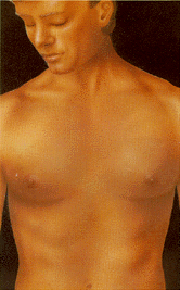
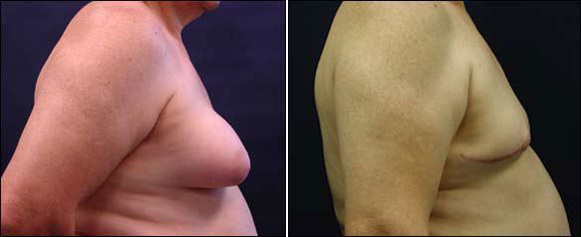
62 year old male before and 6 weeks after excisional correction of gynecomastia picture. Notice the much improved appearance.
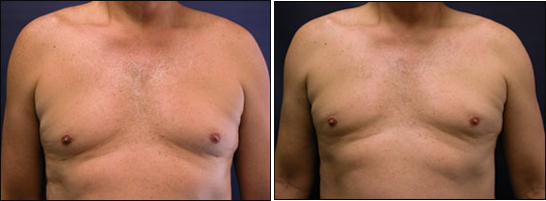
51 year old male before and 6 weeks after liposuction correction of gynecomastia pictures. The only scars are a small 1 cm scar on each side.
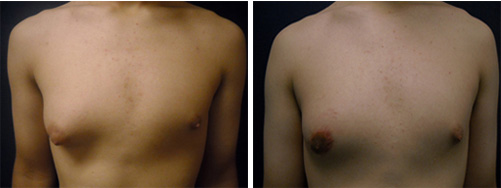
21year old male before and 6 weeks after right Short-scar chest lift for correction of gynecomastia. This involves liposuction of the area but also includes direct excision of the redundant areola. His areolar diameter went from 48mm preop to a more normal 22mm postop. Nothing was done to the left side. His result will improve as liposuction takes 3-6 months to see the final result and is also dependent on workout regimen after the 6 week check up.
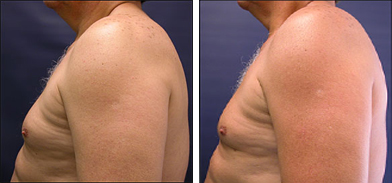
51 year old male before and 6 weeks after liposuction correction of gynecomastia. Notice the improved appearance even in this older gentleman with loose skin tone.

45 year old male before and 6 weeks after liposuction and periareolar excision correction of gynecomastia. Notice the much improved appearance with minimal scarring.
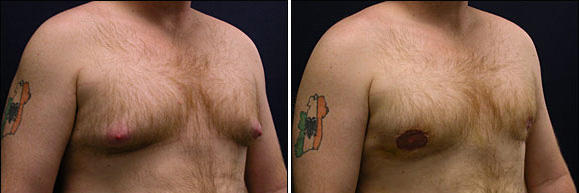
45 year old male before and 6 weeks after liposuction and periareolar excision correction of gynecomastia. Notice the flatter contour and natural appearance. The periareolar excision can be repeated every six to 12 months until the patient is happy with the desired appearance.
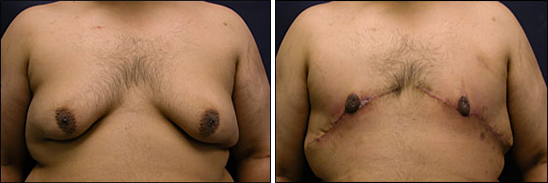
23 year old male before and 6 weeks after excisional correction of gynecomastia. He was a size C before surgery. He had already had prior liposuction by a prominent plastic surgeon in Chicago and not by me! He was unhappy with his excess skin and did not notice much volume reduction after his liposuction procedure. Notice the improved symmetry. His scars will look much better when they mature.
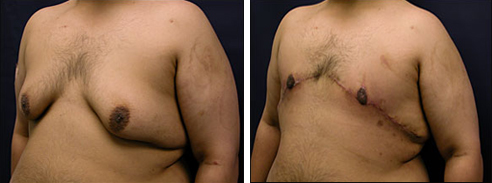
23 year old male before and 6 weeks after excisional correction of gynecomastia. His transition zones laterally will settle down some more as I performed some liposuction laterally for better contouring. Notice the improved symmetry.
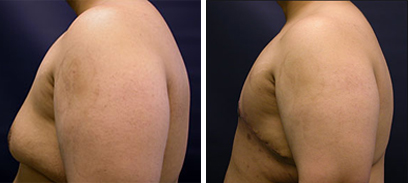
23 year old male before and 6 weeks after excisional correction of gynecomastia. This is considered a great result. Notice the much flatter appearance.